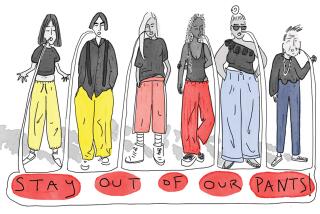Q: Where can I find a...
- Share via
Q: Where can I find a pattern for pants with those elastic straps that slip over the instep? I want to make some tights with that type of attachment.--A.T. A: Those straps that slip over the instep are called stirrups, and they’re providing the tautest trouser look since ski pants left the slopes for the streets in the ‘60s. Stretch & Sew Pattern 318 features the stirruped dance tights illustrated here. Suggested fabrics are knits with 75% lengthwise and crosswise stretch. That means they must have spandex content. Caution: When patterns say “for stretch knits only,” they mean for stretch knits only. The patterns drafted for knits are entirely different from those drafted for woven fabrics, and if you substitute fabrics you are in for a disaster. Stretch & Sew also has a pattern (No. 719) for a pull-on pant with stirrups. The company’s president, Ann Person, recommends that it be made in a cotton interlock.
Q: I don’t consider myself overweight, yet I can’t find panty hose that fit at the waistline. They all force my stomach to pooch out above and below. Can you recommend a brand of panty hose without those constricting waistlines?--E.P. A: You can make do with your existing panty hose if you follow the advice printed in Jane Shaner’s Silver Thimble, a monthly newsletter for those who sew. Simply clip the elasticized waist in four to six places around the top. Stop about a quarter of an inch from the bottom of the elastic. The slits will not get longer and will not cause runs in the hose.
Q: Lately, I have found many garments with the fiber content labeled ramie. My dictionary describes it as “a fine cloth made from the fiber of an Asiatic plant, ramie.” Is this a dressy or a sporty fabric? Should it be treated like silk or rayon . . . or what?--L.H. A: Ramie, also known as rhea or China grass, grows in tropical and subtropical countries and yields a fiber similar to flax. It was used traditionally to make fishing nets and fire hoses. New technology has made it easier to manipulate and less expensive to process. Designers like it because it has many of the advantages of other natural fibers. It is a strong and lustrous fiber and usually has a slightly irregular yarn, giving it a natural-looking texture. Like cotton, rayon and linen, it is absorbent and comfortable to wear. It should be cared for in the same way you care for linen and cotton--either washed or dry-cleaned, depending on the instructions on the care label. The people at the International Fabricare Institute say that it should be ironed while still damp, or misted thoroughly with a water spray and ironed with a steam iron at a high temperature.
Marylou Luther welcomes questions for use in this column. She regrets she cannot answer mail personally. Send your questions to Clotheslines, Los Angeles Times, Times Mirror Square, Los Angeles 90053.


